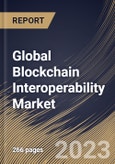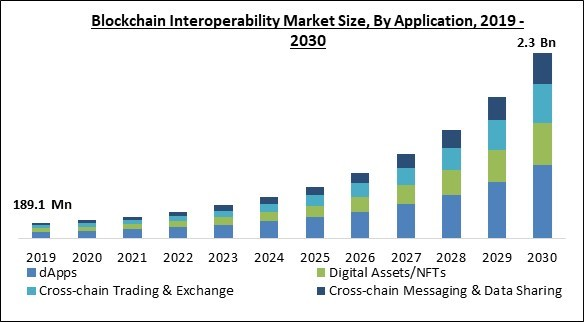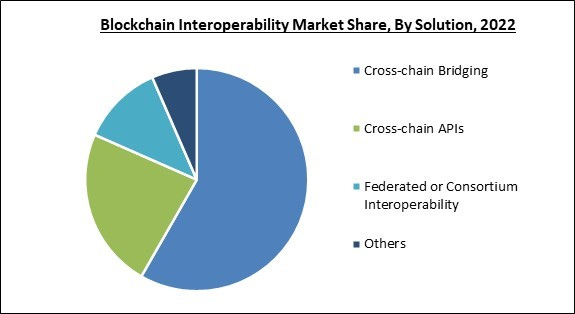The Global Blockchain Interoperability Market size is expected to reach $2.3 billion by 2030, rising at a market growth of 28% CAGR during the forecast period.
Utilizing blockchain interoperability, the healthcare industry addresses the issue of fragmented healthcare records, resulting in enhanced access to comprehensive patient data. Hence, the Healthcare sector acquired $26 million revenue in the market in 2022. Healthcare sector is propelled primarily by the rising demand for streamlined data exchange among multiple stakeholders. This includes hospitals, insurers,clinics,and patients who need a secure and standardized communication system. A notable benefit of blockchain technology in healthcare is its comprehensive security features, which ensure data protection and regulatory compliance. In addition, implementingblockchain-enabled innovations in areas like patient consent management, supply chain transparency,clinical trials, and fraud prevention accelerates the growth of blockchain interoperability in the health care segment. Some of the factors impacting the market are increasing advancements in dApps, Interrelated IoT, and lack of knowledge and comprehension.
The market is driven by the rapid development and pervasive adoption of dApps across industries such as finance, supply chain management, and healthcare. dApps may be utilized to facilitate peer-to-peer financial transactions, likecurrency exchange and asset transfer. dApps can be utilized to monitor the passage of products throughout a supply chain, ensuring accountability and transparency. dApps can be utilized to develop decentralized social media platforms, enabling users to collaborate and share content without a central authority. With interoperability, IoT devices can utilize blockchain's distributed ledger technology to record and verify transactions and sensor data in a secure manner, thereby enhancing data integrity and fostering trust. In IoT deployments, blockchain interoperability improves privacy,security, and decentralized identity management. These developments enable inventive IoT applications in smart cities, healthcare,supply chain management, and energy management by fostering efficiency, cost reduction, and automation. These factors are estimated to propel the market.
However, a significant barrier to blockchain interoperability is a lack of understanding and comprehension of the technology, particularly among small and medium-sized enterprises. Many businesses lack understanding of blockchain technology and its prospective applications. It can be difficult for individuals and organizations unfamiliar with the technology to envisage real-world applications for blockchain beyond cryptocurrencies. Without concrete examples of how blockchain can address actual problems, it is more difficult to inspire interest and investment in technology.
The market research report covers the analysis of key stake holders of the market. Key companies profiled in the report include Oracle Corporation, R3, LeewayHertz, Ontology, INERY PTE. LTD., Datachain, Inc., Quant Network Limited, Band protocol, LiquidApps and Orb Labs.
Utilizing blockchain interoperability, the healthcare industry addresses the issue of fragmented healthcare records, resulting in enhanced access to comprehensive patient data. Hence, the Healthcare sector acquired $26 million revenue in the market in 2022. Healthcare sector is propelled primarily by the rising demand for streamlined data exchange among multiple stakeholders. This includes hospitals, insurers,clinics,and patients who need a secure and standardized communication system. A notable benefit of blockchain technology in healthcare is its comprehensive security features, which ensure data protection and regulatory compliance. In addition, implementingblockchain-enabled innovations in areas like patient consent management, supply chain transparency,clinical trials, and fraud prevention accelerates the growth of blockchain interoperability in the health care segment. Some of the factors impacting the market are increasing advancements in dApps, Interrelated IoT, and lack of knowledge and comprehension.
The market is driven by the rapid development and pervasive adoption of dApps across industries such as finance, supply chain management, and healthcare. dApps may be utilized to facilitate peer-to-peer financial transactions, likecurrency exchange and asset transfer. dApps can be utilized to monitor the passage of products throughout a supply chain, ensuring accountability and transparency. dApps can be utilized to develop decentralized social media platforms, enabling users to collaborate and share content without a central authority. With interoperability, IoT devices can utilize blockchain's distributed ledger technology to record and verify transactions and sensor data in a secure manner, thereby enhancing data integrity and fostering trust. In IoT deployments, blockchain interoperability improves privacy,security, and decentralized identity management. These developments enable inventive IoT applications in smart cities, healthcare,supply chain management, and energy management by fostering efficiency, cost reduction, and automation. These factors are estimated to propel the market.
However, a significant barrier to blockchain interoperability is a lack of understanding and comprehension of the technology, particularly among small and medium-sized enterprises. Many businesses lack understanding of blockchain technology and its prospective applications. It can be difficult for individuals and organizations unfamiliar with the technology to envisage real-world applications for blockchain beyond cryptocurrencies. Without concrete examples of how blockchain can address actual problems, it is more difficult to inspire interest and investment in technology.
Solution Outlook
Based on solution, the market is segmentedinto cross-chainbridging, cross chain APIs, federated or consortium interoperability, and others. In 2022, the Cross-chain bridging segment dominated the market with the maximum revenue share. Typically, a cross-chain bridge entails securing or destroying tokens on the source chain via a smart contract and unlocking or minting tokens on the destination chain via a second smart contract. Cross-chain bridges augment the utility of tokens by facilitating cross-chain transactions between distinct blockchains. This benefit is the primary contributor to the segment's growth and increased popularity.Vertical Outlook
On the basis of vertical the market is segmented into BFSI, healthcare, gaming & entertainment, IT & ITes, telecommunication, food & agriculture, and others. In 2022, the BFSI segment held the largest revenue share on the market. This is due to the requirement for secure data exchange and expedient transactions within the industry. In addition to providing transparency and enhanced security, blockchain technology is an optimal solution for the BFSI industry. In addition, interoperability allows seamless communication between various organizations operating on different blockchain networks andfacilitates cross-border transactions, interbank settlements, and the processing of insurance claims.Application Outlook
Based on application, the market is segmented by application into dApps, Digital Assets/NFTs, cross chain trading & exchange, and cross-chainmessages & data sharing. The digital assets/NFTs segment covered a considerable revenue share in the market in 2022. NFTs are tradable and can be exchanged for cash, cryptocurrencies, and other NFTs. Non-fungible tokens are extremely beneficial for identity security. For instance, personal data stored on an immutable blockchain cannot be accessed, taken, or used without the corresponding keys. The most recent development in the realm of NFTs is utilities. Unlocking comprehensive and interactive experiences that combine the digital and corporeal realms in never-before-seen ways requires utilities.Regional Outlook
Region wise, the market is analyzed across North America, Europe, Asia-Pacific, and LAMEA. In 2022, the North America region witnessed the largest revenue share in the market. North America retains the largest market share in the market due to several important factors. These include the region's growing adoption of blockchain technology in a variety of industries, including healthcare, supply chain management, and finance. In addition, well-established North American vendors and government initiatives and investments have contributed to the region's expansive market. North America has positioned itself as a prominent center for blockchain interoperability solutions through a proactive approach to nurturing innovation and collaboration.The market research report covers the analysis of key stake holders of the market. Key companies profiled in the report include Oracle Corporation, R3, LeewayHertz, Ontology, INERY PTE. LTD., Datachain, Inc., Quant Network Limited, Band protocol, LiquidApps and Orb Labs.
Scope of the Study
By Solution
- Cross-chain Bridging
- Cross-chain APIs
- Federated or Consortium Interoperability
- Others
By Application
- dApps
- Digital Assets/NFTs
- Cross-chain Trading & Exchange
- Cross-chain Messaging & Data Sharing
By Vertical
- BFSI
- Healthcare
- Gaming & Entertainment
- Telecommunication
- Food & Agriculture
- IT & ITeS
- Others
By Geography
- North America
- US
- Canada
- Mexico
- Rest of North America
- Europe
- Germany
- UK
- France
- Russia
- Spain
- Italy
- Rest of Europe
- Asia Pacific
- China
- Japan
- India
- South Korea
- Singapore
- Malaysia
- Rest of Asia Pacific
- LAMEA
- Brazil
- Argentina
- UAE
- Saudi Arabia
- South Africa
- Nigeria
- Rest of LAMEA
Key Market Players
List of Companies Profiled in the Report:
- Oracle Corporation
- R3
- LeewayHertz
- Ontology
- INERY PTE. LTD.
- Datachain, Inc.
- Quant Network Limited
- Band protocol
- LiquidApps
- Orb Labs
Unique Offerings
- Exhaustive coverage
- The highest number of Market tables and figures
- Subscription-based model available
- Guaranteed best price
- Assured post sales research support with 10% customization free
Table of Contents
Chapter 1. Market Scope & Methodology
Chapter 2. Market At a Glance
Chapter 3. Market Overview
Chapter 4. Global Blockchain Interoperability Market by Solution
Chapter 5. Global Blockchain Interoperability Market by Application
Chapter 6. Global Blockchain Interoperability Market by Vertical
Chapter 7. Global Blockchain Interoperability Market by Region
Chapter 8. Company Profiles
Companies Mentioned
- Oracle Corporation
- R3
- LeewayHertz
- Ontology
- INERY PTE. LTD.
- Datachain, Inc.
- Quant Network Limited
- Band protocol
- LiquidApps
- Orb Labs
Methodology

LOADING...










